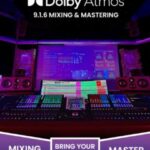In the music industry, you must have come across the most used term right now- Dolby Atmos. Am I correct? However, you won’t find much information about Dolby Atmos on the internet.
With the invention of Dolby Atmos, the “object-based audio format”, the scenario of the music industry has been completely changed. Dolby Atmos provides you with the most immersive, and high-quality audio, you would have ever heard.
But when it comes to mixing your Dolby Atmos music, most of you tend to make mistakes. Let’s be clear, there are two main digital audio schemes that are used by streaming services and make any music mix alive- EC-3 and AC-4 IMS.
As a beginner in the music industry, the field, you might not be familiar with these terms. But, let me tell you, these two are one of the most important elements that can strongly impact your music mix.
I don’t want to drag you into the stream of technical details. So, I will just tell you what these actually are, without digging deeper.
EC-3 is a mixing format primarily used for playback using speakers. If you have used Apple Music sometimes, you must be familiar with how the music sounds. Amazon Echo and Blu-ray users use EC-3 the most.
Now, what’s AC-4?
AC-4 is mainly used by music streaming services/ applications- TIDAL, Hungama, and Anghami. The music apps that play back in your tiny Android phone. Let me tell you, AC-4 does not use binaural metadata, which we usually embed while mixing music.
Don’t worry, if you don’t know about any of these, there’s always the first time. In this blog, we will discuss the major, useful, and advanced tips and tricks from Dolby Atmos Studio Atlanta experts that you should consider while mixing Dolby Atmos for Music.
So, why waste time, let’s start!

1. Understand the spatial framework:
As a mixing engineer, you must be thinking of using stereo wideners, or harmonic processing to have a conventional mix. But let me tell you, these techniques are not that easy, or should I say doesn’t work in the case of a Dolby Atmos music mix.
Let me make it easy to understand. Mixing a song that has already been released as a stereo mix, is a way tougher task than it seems to be. You might also find binaurals that have perfect spatial accuracy but lack the punch. That is why you need to make sure, which object in your mix needs to have an enabled binaural positioning.
The binaural version sounds truly amazing, and immersive, if used correctly. Plus, it provides you with the best experience that you ever had before.
( Also Read More – Dolby Atmos Music Mastering )
2. Prioritize mixing hierarchy:
Hierarchy is important, especially when your work is to make a Dolby Atmos music mix. Every element should be in a hierarchical order. So, make sure you define all the elements of your music properly into primary, secondary, and ambient.
- Anchor the core: make sure you keep all the essential components like bass, lead vocals, and kick drums centralized and also panned.
- Spread all the supporting elements: elements of the mix- pads, background vocals, and effects should be distributed properly all across the immersive field. This should be done to avoid any type of crowding in your mix’s focal points.
3. Optimize for your playback formats:
Suppose you own a set of headphones, earphones, soundbars, or cinema setup and listen to music, or podcasts on your different devices. You must have felt a little difference in the sound quality, and the playback system.
This is because Dolby Atmos mixes work differently for different devices.
So, how can you make them work similarly for all devices? Well, you can optimize them.
- Headphone optimization: You can use binaural rendering tools that will help you understand and preview your mix. How your mix will sound on your headphones, and adjust the level and spatialization accordingly.
- Speaker adaptation: As a mixing engineer your work should be to test your Dolby Atmos music mix on various speakers. And make sure that it balances across all systems.
4. Add Movement to Pans for a Dynamic Mix:
Even a single tiny movement brings any music mix to life and adds soul to it. Flipping your pans to faders and randomly moving some elements slightly, is what you need to make your mix sound dynamic.
You can sometimes set your auto glide time to match the sound tempo, trust me this really helps. Doing this will make your mix sound lyrical, and musical, even though your pan faders are pushed randomly.
Sounds like a lifesaver, right?
( Read More – Dolby Atmos for the Home: Sound Bar Setup Guide )
5. Make use of automation for depth:
One of the reasons why most musicians use, and the evolution of the music industry towards the use of Dolby Atmos, is automation. The quality depth and effective automation facility are the powerful tools in the Dolby Atmos mix.
- Panning automation: panning automation is nothing but a method of adding cinematic effects by gradually moving sound elements in the listener’s space. It makes a hit-hat pattern around a circle for an ethereal effect.
- Volume dynamics: Volume changes the immersion, motion, and depth of the music, making it clearer to listen to. Especially when there is a transition or a sound drop.
- Reverb and delay adjustments: Spatial audio has redefined the whole concept of how headphones and smartphones deliver sounds. If you adjust to spatial audio dynamically, you can make the audio environment feel more alive and evolving.
Final words:
Recording music can turn out to be a tough task especially when you are a beginner in this field.
Just remember to be organized, have a plan, take your time, and follow the tips mentioned in this blog.
In this blog, we discussed the 5 advanced tips and tricks you should follow for better Dolby Atmos mixing. If you are someone who’s facing difficulties in finding the best Dolby Atmos studios in Georgia. Don’t worry, we got you. Dolby Atmos Studio Atlanta is one of the best recording studios in Atlanta for music production.

